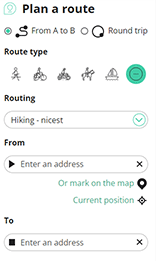

Numerous rest areas along the Frontzate thanks to Westtoer.
The cycle path “De Frontzate” is located on the former railway bed of line 74, built in 1868. This railway line connected Diksmuide with Nieuwpoort and played a strategic role during WW I. The route is 14 km long.
It is not for nothing that this cycle path is called the 'Frontzate'. The elevated railway embankment served as a buffer during the Battle of the Yser in 1914, when the entire polder plain between the Yser and the railway was flooded. The Belgian army held out behind this railway embankment.
The railway played a strategic role as a Belgian defense line against the German army. The flooding of the Yzervlakte with the railway dike as a flood defense in 1914, could stop the advance of the Germans. The area between the Yser and the railway bed was transformed into a swampy area, with a number of islands protruding above it, which were set up by the Belgians and the Germans as outposts in no man's land.
The Belgian first line was constructed behind and in the railway embankment. Partly due to the proximity of the brickworks of Wulpen (Koksijde), the shelters could be built in brick. The shelters were protected with sandbags. Depending on the condition of the ground, the trenches could be constructed underground or semi-above ground. Wooden footbridges (passerelles) ran from the railway bed to the outposts in the flooded area.
Numerous brick and concrete structures from the First World War have been preserved on either side of the railway bed. Especially on the west side at regular intervals (remnants of) fairly similar, usually rectangular yellow or red brick constructions. Most of the roofs have disappeared and the walls are often partially demolished. These constructions functioned as shelters for the men who kept watch here. Two square brick structures probably functioned as shooting posts. The building with ovens and chimneys was a military kitchen.
The less numerous concrete structures in various shapes - also with damage - are situated on both sides of the railway bed. The concrete Red Cross post is recognizable by a medallion.
Also traces of at least two constructions from the Second World War, in particular two so-called Tobruk positions in Ramskapelle and Nieuwpoort. A number of other concrete structures (including some gun emplacements) may also date from the Second World War.

Select one of the most popular activities below or refine your search.
Discover the most beautiful and popular trails in the area, carefully bundled into appropriate selections.
Select one of the most popular categories below or be inspired by our selections.
Discover the most beautiful and popular attractions in the area, carefully bundled in appropriate selections.
With RouteYou, it's easy to create your own customised maps. Simply plot your route, add waypoints or nodes, add places of interest and places to eat and drink, and then easily share it with your family and friends.
Route planner

<iframe src="https://plugin.routeyou.com/poiviewer/free/?language=en&params.poi.id=8224628" width="100%" height="600" frameborder="0" allowfullscreen></iframe>
Try this feature for free with a RouteYou Plus trial subscription.
If you already have such an account, then log in now.
© 2006-2024 RouteYou - www.routeyou.com